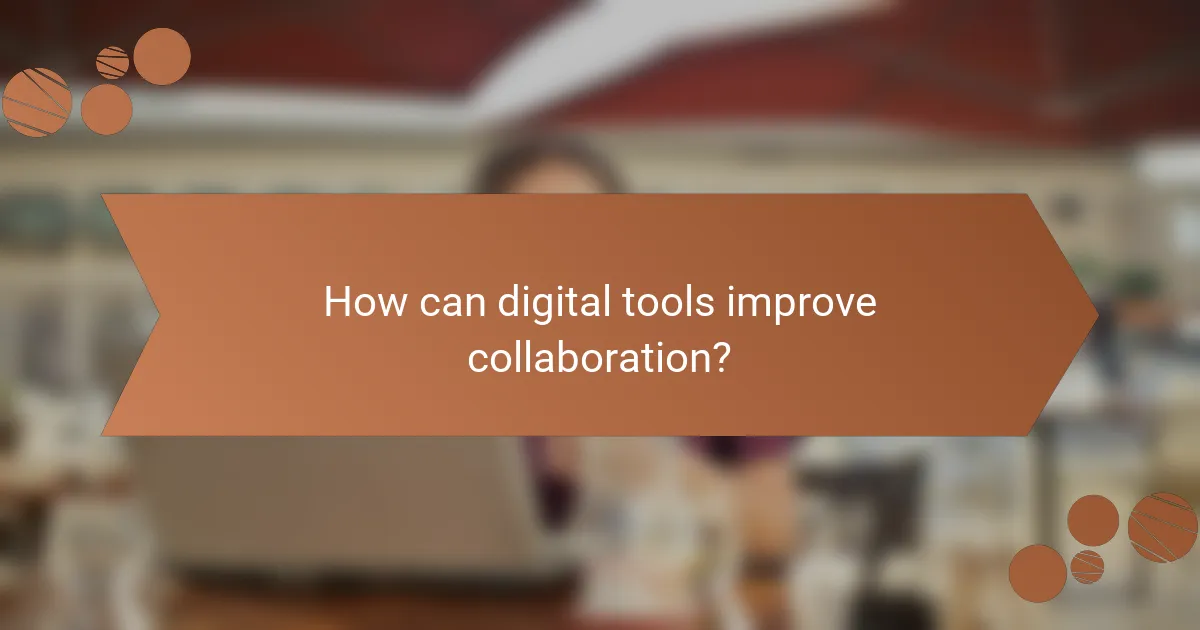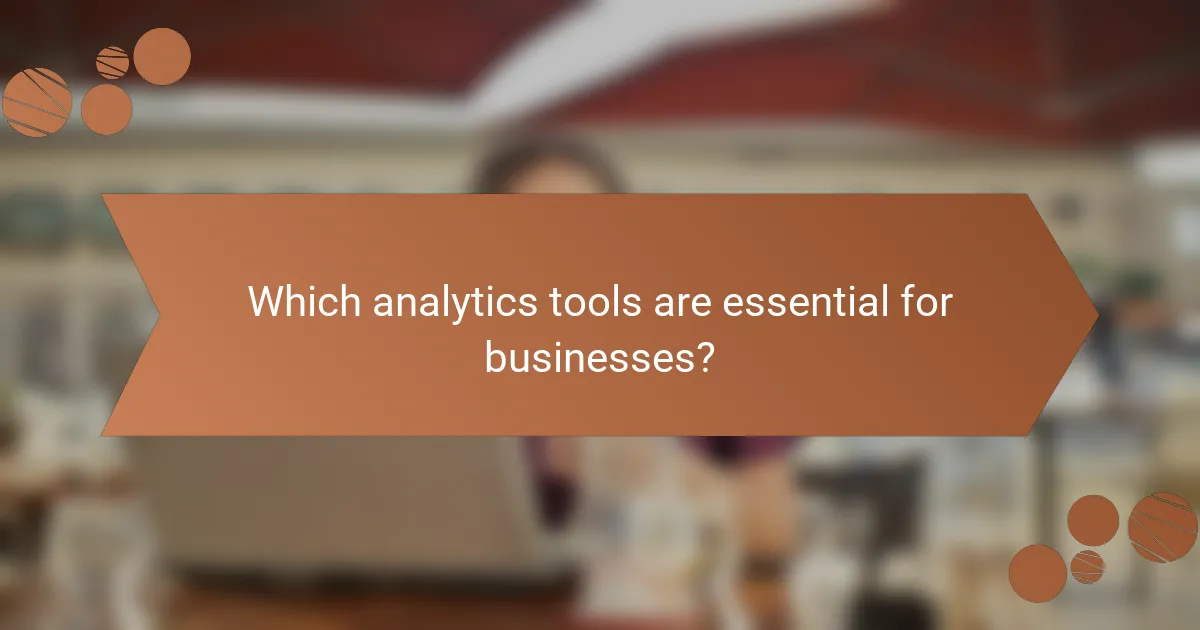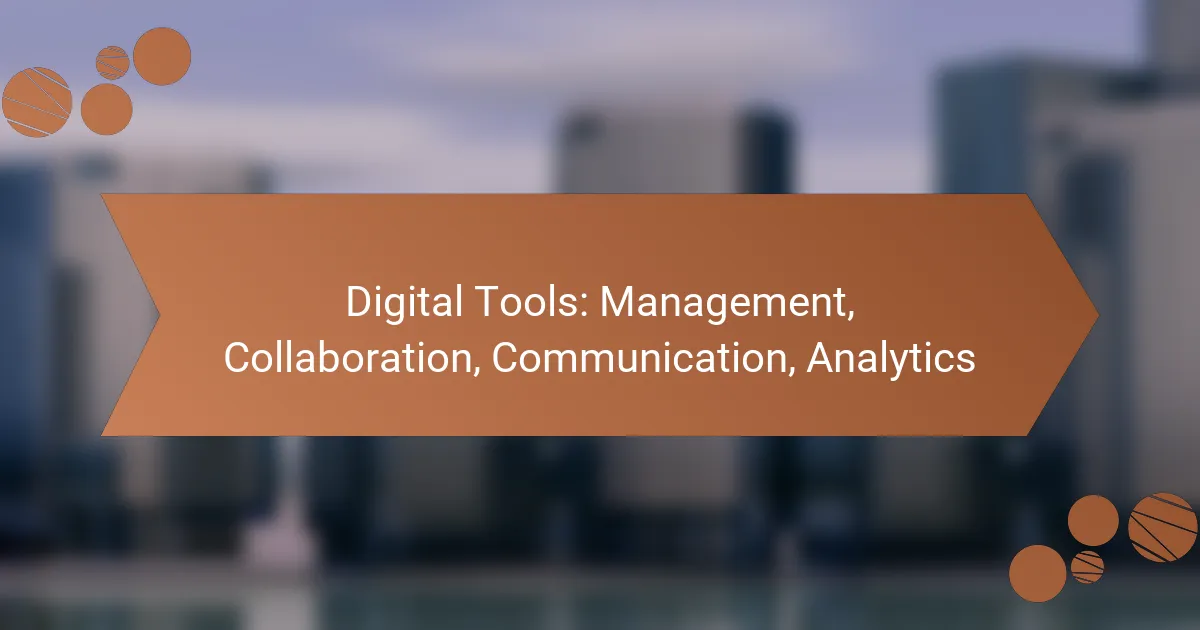In today’s fast-paced work environment, digital tools play a crucial role in management, collaboration, communication, and analytics. These tools streamline workflows, enhance team interactions, and provide valuable insights, enabling organizations to operate more efficiently and effectively. By leveraging the right digital solutions, teams can improve productivity and achieve better project outcomes, regardless of their physical locations.

What are the best digital tools for management?
The best digital tools for management streamline workflows, enhance team collaboration, and improve task tracking. Effective tools cater to specific needs, whether it’s project management, task tracking, or resource allocation.
Trello for project management
Trello is a visual project management tool that uses boards, lists, and cards to organize tasks. Users can easily drag and drop cards to reflect progress, making it intuitive for teams to see the status of projects at a glance.
It’s particularly useful for small to medium-sized teams looking for a straightforward way to manage projects without overwhelming features. Trello offers a free version, which is suitable for basic needs, while premium plans provide advanced functionalities.
Asana for task tracking
Asana excels in task tracking by allowing users to create tasks, assign them to team members, and set deadlines. Its interface supports both list and board views, catering to different preferences for task management.
This tool is ideal for teams that require detailed task management and progress tracking. Asana integrates with various other tools, enhancing its functionality, and offers a free tier for basic use, with paid plans for more advanced features.
Monday.com for team collaboration
Monday.com is a versatile platform designed for team collaboration, featuring customizable workflows and visual project tracking. It allows teams to manage projects, tasks, and resources in one place, promoting transparency and accountability.
This tool is suitable for teams of all sizes, with pricing plans that scale based on the number of users and features. Its flexibility makes it a good choice for organizations that need to adapt their workflows frequently.
Wrike for resource management
Wrike focuses on resource management, providing tools to allocate tasks and monitor team workloads effectively. It offers real-time visibility into project progress and resource availability, helping managers make informed decisions.
Wrike is particularly beneficial for larger teams or organizations with complex project demands. It features advanced reporting capabilities and integrates with various applications, but it may require a learning curve for new users.
ClickUp for all-in-one management
ClickUp is an all-in-one management tool that combines project management, task tracking, and goal setting in a single platform. Its customizable features allow teams to tailor the interface to their specific needs, making it highly adaptable.
This tool is suitable for teams looking for a comprehensive solution without needing multiple applications. ClickUp offers a free version with essential features, while paid plans unlock advanced functionalities, making it accessible for different budget levels.

How can digital tools improve collaboration?
Digital tools enhance collaboration by streamlining communication, facilitating real-time feedback, and centralizing resources. These tools allow teams to work together more efficiently, regardless of their physical location, ultimately leading to improved productivity and project outcomes.
Slack for team communication
Slack is a messaging platform designed for team communication, allowing users to create channels for specific topics or projects. This organization helps reduce email clutter and ensures that relevant discussions are easily accessible. Teams can share files, integrate with other tools, and use features like direct messaging to enhance interaction.
To maximize Slack’s effectiveness, establish clear guidelines on channel usage and encourage regular check-ins. Avoid overwhelming team members with excessive notifications by customizing alert settings based on priority.
Microsoft Teams for video conferencing
Microsoft Teams offers a robust platform for video conferencing, enabling seamless virtual meetings with features like screen sharing and file collaboration. Teams can host meetings with up to several hundred participants, making it suitable for both small and large groups.
To ensure productive meetings, set a clear agenda in advance and use the recording feature for those who cannot attend. Encourage participants to use video to foster engagement and connection among team members.
Zoom for virtual meetings
Zoom is a widely used tool for virtual meetings, known for its user-friendly interface and high-quality video capabilities. It supports a variety of meeting formats, including webinars and breakout rooms, which can enhance collaboration during larger sessions.
To optimize your Zoom experience, familiarize yourself with its features, such as virtual backgrounds and meeting polls. Always test your audio and video settings before a meeting to avoid technical issues that could disrupt collaboration.
Google Workspace for document sharing
Google Workspace provides a suite of tools for document sharing and collaboration, including Google Docs, Sheets, and Slides. These applications allow multiple users to edit documents simultaneously, making it easy to gather input and make real-time changes.
To effectively use Google Workspace, establish clear permissions for document access and editing. Utilize comments and suggestions features to facilitate constructive feedback while maintaining version control to track changes over time.
Notion for collaborative workspaces
Notion is a versatile tool that combines note-taking, task management, and database functionalities into a single platform. It allows teams to create shared workspaces where they can collaboratively manage projects, track progress, and store important information.
To get started with Notion, define the structure of your workspace and encourage team members to contribute to shared pages. Regularly review and update content to keep information relevant and useful for all collaborators.

What are the key features of communication tools?
Communication tools are designed to facilitate effective interaction among team members, enhancing collaboration and productivity. Key features include real-time messaging, file sharing, integration with other platforms, mobile accessibility, and robust security measures.
Real-time messaging capabilities
Real-time messaging allows users to communicate instantly, making it easier to discuss ideas and resolve issues quickly. This feature often includes group chats, direct messaging, and notifications to keep conversations flowing without delays.
When choosing a tool, consider platforms that support rich media sharing, such as images and videos, as well as threaded conversations to maintain context. Popular options include Slack and Microsoft Teams, which offer these functionalities effectively.
File sharing options
File sharing options enable users to upload and share documents, images, and other files seamlessly within the communication tool. This feature is essential for collaborative work, allowing team members to access and edit shared files in real-time.
Look for tools that support various file formats and provide version control to track changes. Services like Google Drive and Dropbox integration can enhance file sharing capabilities, ensuring easy access and collaboration.
Integration with other platforms
Integration with other platforms is crucial for streamlining workflows and enhancing productivity. Communication tools should connect with project management software, calendars, and CRM systems to centralize information and reduce the need to switch between applications.
Evaluate tools based on their ability to integrate with the software your team already uses. For instance, tools like Zapier can help automate tasks between different applications, improving efficiency.
Mobile accessibility
Mobile accessibility ensures that team members can communicate and collaborate on the go. A good communication tool should have a mobile app that offers similar functionalities to its desktop version, allowing users to stay connected anytime, anywhere.
When assessing mobile accessibility, check for features like push notifications, offline access, and user-friendly interfaces. This is particularly important for teams that work remotely or travel frequently.
Security features
Security features are vital for protecting sensitive information shared through communication tools. Look for end-to-end encryption, two-factor authentication, and compliance with data protection regulations like GDPR to ensure your data remains secure.
Regularly review the security protocols of your chosen tools and stay updated on any changes. Prioritizing security helps safeguard your organization against potential data breaches and maintains trust among team members.

Which analytics tools are essential for businesses?
Essential analytics tools for businesses include platforms that help track performance, visualize data, and derive actionable insights. These tools enable companies to make informed decisions based on data-driven analysis, enhancing overall efficiency and effectiveness.
Google Analytics for web traffic analysis
Google Analytics is a powerful tool for analyzing web traffic, allowing businesses to understand user behavior on their websites. It provides insights into visitor demographics, traffic sources, and user engagement metrics, which can inform marketing strategies.
To effectively use Google Analytics, set up goals to track conversions and utilize UTM parameters for campaign tracking. Regularly review reports to identify trends and areas for improvement, ensuring your website meets user needs.
Tableau for data visualization
Tableau is renowned for its data visualization capabilities, enabling users to create interactive and shareable dashboards. It transforms complex data sets into visual formats, making it easier to identify patterns and insights.
When using Tableau, focus on selecting the right data sources and visualizations that best represent your findings. Consider integrating Tableau with other data tools to enhance its functionality and ensure your visualizations are both informative and engaging.
Power BI for business intelligence
Power BI is a business intelligence tool that helps organizations analyze data and share insights across the company. It offers robust reporting features and integrates seamlessly with various Microsoft products, making it a popular choice for businesses already using the Microsoft ecosystem.
To maximize Power BI’s potential, leverage its data modeling capabilities and create custom reports tailored to different stakeholders. Regularly update your dashboards to reflect real-time data, ensuring decision-makers have access to the latest information.
HubSpot for marketing analytics
HubSpot provides comprehensive marketing analytics tools that track the performance of campaigns and customer interactions. It allows businesses to measure key metrics such as lead generation, conversion rates, and customer engagement.
Utilize HubSpot’s reporting features to analyze the effectiveness of your marketing strategies. Regularly assess your campaigns and adjust tactics based on performance data to optimize your marketing efforts and improve ROI.
Mixpanel for product analytics
Mixpanel specializes in product analytics, focusing on user interactions within applications. It helps businesses understand how users engage with their products, allowing for data-driven product development and enhancements.
To effectively use Mixpanel, define key user actions and track them over time. Analyze retention rates and user funnels to identify drop-off points, enabling you to make informed decisions to improve user experience and increase engagement.



